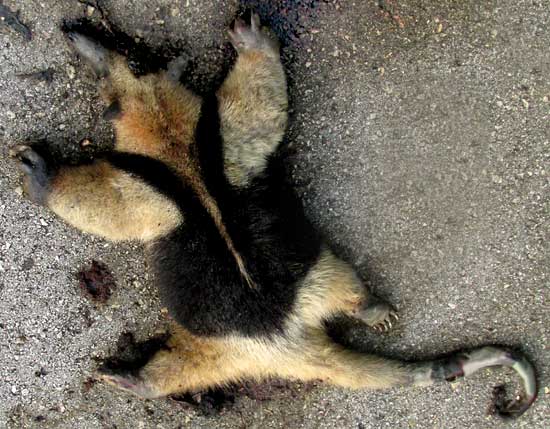Excerpts from Jim Conrad's
Naturalist Newsletter
from the August 23, 2018 Newsletter issued from Rancho Regenesis in the woods ±4kms west of Ek Balam Ruins; elevation ~40m (~130 ft), N~20.876°, W~88.170°, central Yucatán, MÉXICO
COLLARED ANTEATER ROADKILL
My first and only encounter with a live Collared Anteater, Tamandua mexicana took place in the Yucatan back in 2005 {following entry}. Then I described the creature as one of the most handsome free-roaming mammals I'd ever seen, and that's still the case. Therefore, I had mixed feelings when on my Sunday morning biking trip to Temozón to buy fruit I came across one a car had run over, at the side of the road. It was sad seeing such a beautiful, rarely observed animal left dead like that. On the other hand, I was glad to know that they're still in the area, unless this was the last one.
In 2005 I didn't have a camera to photograph the one I met then, so I photographed the roadkill, both to document the sighting, and because the coat of this animal is so plush and elegantly patterned that it can be admired even on one in this state. It's below:

Collard Anteaters not only eat ants but also termites and bees, and probably a little fruit. Their hard, sharp claws on the powerful forearms are used to break into insect nests, and to defend themselves. The claws on the forefeet are so curved that the animal walks on the feet outer surfaces to avoid puncturing their own palms.
Probably the species is more common here than it seems, the reason being that mainly the are nocturnal. Normally they spend their days in hollow tree trunks or the burrows of other animals. They're solitary and range over territory that average from 250 to 930 acres (100 to 375ha), depending on the environment.
from the January 23, 2005 Newsletter written at Hacienda Komchen de Los Pájaros
just outside Dzemul, Yucatán, MÉXICO
ENCOUNTER WITH A COLLARED ANTEATER
Wednesday morning about half an hour before the sun came up I was jogging down Komchen's gravel road when in the dim light I saw a fox-size darkness coming at me. It was so boldly marked black and white that I assumed it was a skunk, but closer up its very long snout and powerful-looking prehensile tail showed that it was an anteater. It was the Collard Anteater, TAMANDUA MEXICANA, and it was one of the most handsome free-roaming mammals I've ever seen.
The creature behaved in the vacillating way of an armadillos -- as if it couldn't quite decide whether I was something to be reckoned with or just a tree. It looked and sniffed, and started and stopped, first one direction then another, and all the time I was standing there thinking how like a skunk it smelled. I was surprised by that because anteaters and skunks not only belong to different mammal families, but also entirely different orders. Skunks, along with such different animals as bears, pumas and coyotes, are in the Order Carnivora (meat-eaters), while anteaters, along with armadillos, are in the Order Edentata (without teeth -- though armadillos do have rudimentary ones).
That doesn't mean that my Collard Anteater should have felt particularly vulnerable. In fact, when I returned to my jogging, apparently my movement caused the critter to decide that I might be a threat, and when I looked back at him over my shoulder, I could hardly believe my eyes.
He had reared onto his hind legs, with his thick tail supporting him from behind, and he looked exactly like a very stubby-limbed, bowlegged, grotesquely long-nosed little man at that point in his story when he's saying, "... and that fish was THIS long," showing a length about as great as his outspread arms can manage.
That anteater was not wishing to embrace me as a friend. Rather, he was positioning himself so that if I should approach him he could slash me with his front legs' very sharp, large and powerful claws.
When I told Ana María about my encounter she was very happy, and also remarked that it's good that our dogs are just normal-size ones, since a Collard Anteater is quite capable of defending itself -- of neatly slitting a medium-size dog's belly from one end to the other.